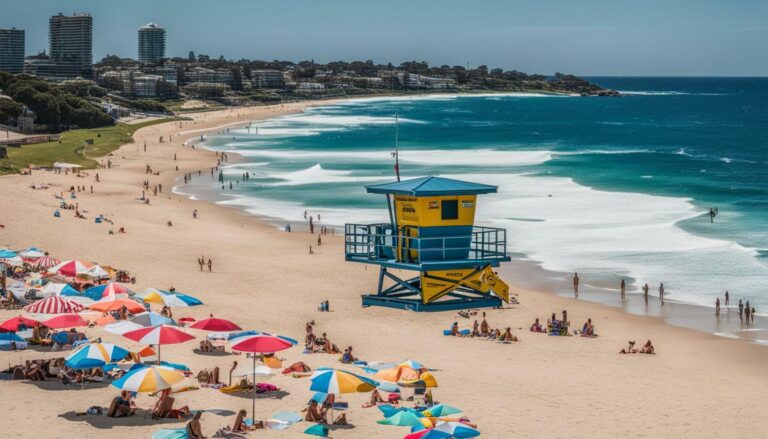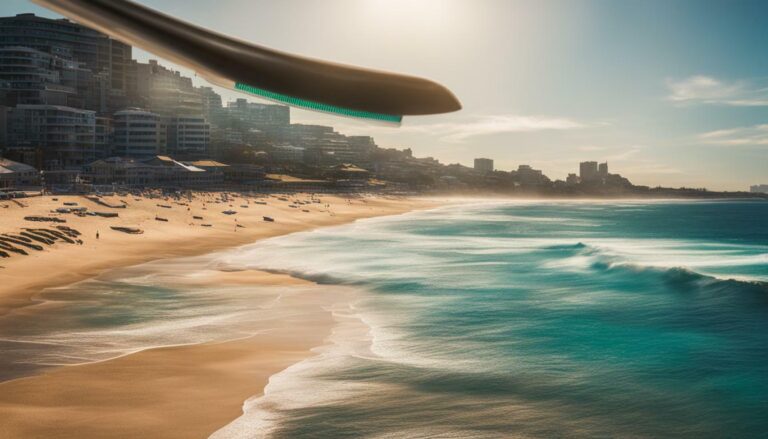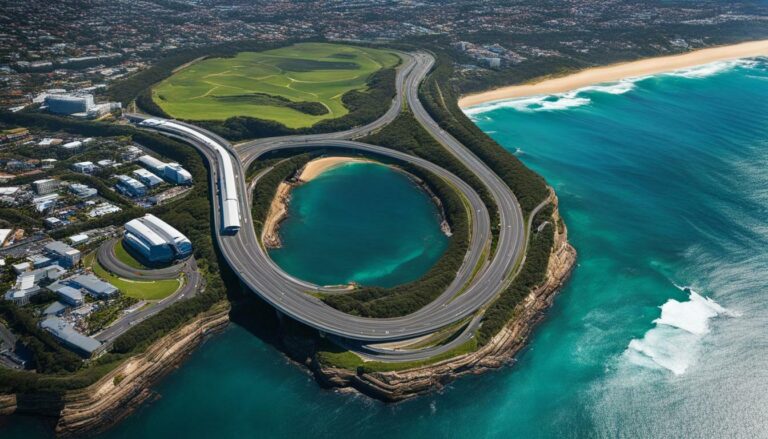Uncovering How Many Drownings at Bondi Beach Occur
Bondi Beach has seen a concerning number of drowning incidents in recent years, prompting the need to delve into the statistics and understand how many drownings occur at this popular beach.
Key Takeaways:
- Bondi Beach has experienced an increase in drownings, with 70 deaths this summer alone.
- 88% of the drownings were male.
- The majority of drownings occurred more than one kilometer away from a surf lifesaving service.
- Rock fishers and bystanders attempting to rescue others have experienced a significant increase in drowning deaths.
- Swimming in unfamiliar locations and visitors from more than 50 kilometers away are also factors in the drownings.
- Swimmers caught in rips are advised to float and conserve energy rather than fighting the current.
- Parents should be vigilant in supervising children near the water, particularly after missed swimming lessons and beach outings due to the pandemic.
The statistics and facts surrounding drownings at Bondi Beach highlight the need for increased water safety measures and awareness. With a focus on preventing further tragedies, it is crucial for both locals and visitors to understand the risks and take necessary precautions when enjoying the beach.
Current Drowning Statistics at Bondi Beach
In recent years, the number of drownings at Bondi Beach has been alarmingly high, necessitating a closer look at the current drowning statistics and the importance of water safety measures in this area. This summer alone, there have been 70 drowning incidents reported along Australia’s coastline, marking an 11% increase from the 10-year average.
It is concerning to note that the majority of these drownings, a staggering 88%, were males. Most of the incidents occurred greater than one kilometer from a surf lifesaving service, underscoring the critical importance of swimming in patrolled areas. Furthermore, there has been a notable rise in drowning deaths among rock fishers and bystanders who attempted to rescue others. Particularly concerning is the significant increase in drowning deaths at rock and cliff locations, primarily among rock fishers.
To combat these alarming trends, experts stress the need for rock fishers to check conditions, understand their limits, and wear life jackets. Additionally, the data reveals a correlation between drownings and swimming in unfamiliar locations, with nearly half of the fatalities involving visitors from more than 50 kilometers away. It is crucial for swimmers, especially those caught in rips, to remember to float and conserve energy rather than fighting against the currents.
As we approach the week between Christmas and New Year, historically the deadliest period for drowning deaths in Australia, lifeguards are urging everyone to be cautious. This year’s summer heatwave may further compound the situation. Parents are particularly advised to closely supervise their children near water, as the pandemic may have caused missed swimming lessons and beach outings. Lifeguards have already reported a busier start to summer, with increased rescues due to higher beach attendance and changes to inland waterways caused by flooding. The focus remains on raising awareness about water safety, especially at popular beach destinations like Bondi Beach, to prevent further drownings.
| Key Statistics: | |
|---|---|
| Total Drownings: | 70 |
| Drowning Incidents Involving Males: | 88% |
| Drownings Occurring Greater Than 1 km from Surf Lifesaving Service: | Most incidents |
| Drownings Among Rock Fishers: | Significant increase |
| Drownings Involving Visitors from >50 km Away: | Nearly half of the fatalities |
Understanding the Factors Contributing to Drownings
To effectively prevent drownings at Bondi Beach, it is crucial to understand the factors that contribute to these water-related accidents and implement appropriate safety measures. Recent data has shed light on the key factors that play a role in the increasing number of drownings in Australia, particularly at locations like Bondi Beach. Analyzing the statistics reveals important insights that can help prevent future tragedies.
One significant contributing factor is the location of the drownings. Many incidents occur greater than one kilometer from a surf lifesaving service, indicating the importance of swimming in patrolled areas. Swimmers should always be aware of their surroundings and choose to swim where lifeguards can provide immediate assistance if needed. It is also essential to acknowledge that swimming and wading are not the only activities associated with drownings. The number of drowning deaths among rock fishers and bystanders attempting to rescue others has witnessed a notable increase.
To address this, it is crucial for rock fishers to be cautious, check the conditions, know their limits, and wear life jackets. Additionally, there is a correlation between drownings and swimming in unfamiliar locations. Nearly half of the fatalities involve visitors who reside more than 50 kilometers from the drowning location but remain in their home state. Therefore, it is essential for swimmers to be aware of local conditions, including rip currents, and exercise caution when exploring new beaches.
The data also highlights the importance of education and awareness. Lifeguards and experts emphasize the need for swimmers caught in rips to float and conserve energy rather than fighting against the current. Furthermore, the week between Christmas and New Year proves to be the deadliest period for drowning deaths in Australia. With the added heatwave this summer, it is crucial for parents to be extra vigilant when supervising children near the water, especially considering the missed swimming lessons and beach outings caused by the pandemic.
| Key Factors Contributing to Drownings at Bondi Beach | Actions to Prevent Drownings |
|---|---|
| Swimming outside of patrolled areas | Always swim in areas where lifeguards are present and can provide immediate assistance. |
| Increased drowning deaths among rock fishers and bystanders | Rock fishers should check conditions, know their limits, and wear life jackets. Bystanders should avoid attempting rescues without proper training and equipment. |
| Swimming in unfamiliar locations | Be aware of local conditions, including rip currents, and exercise caution when exploring new beaches. |
| Parents distracted due to the pandemic | Be extra vigilant when supervising children near the water, as missed swimming lessons and beach outings may increase their risk. |
In conclusion, understanding the factors that contribute to drownings is essential in preventing further water-related accidents at Bondi Beach. By recognizing the importance of swimming in patrolled areas, being cautious while rock fishing, staying informed about local conditions, and prioritizing water safety for children, we can help create a safer beach environment for everyone.
Risks and Challenges at Bondi Beach
Bondi Beach presents unique risks and challenges that swimmers should be aware of to ensure their safety and the safety of others in the water. A recent increase in drownings along Australia’s coastline has raised concerns about beach safety, particularly at Bondi Beach. This summer alone, there have been 70 drownings, representing an 11% increase from the 10-year average. It is crucial to understand the specific risks and challenges at Bondi Beach to prevent further tragedies.
One of the key factors contributing to drownings at Bondi Beach is swimming in unpatrolled areas. Most drownings occurred over one kilometer from a surf lifesaving service, highlighting the importance of swimming in designated safe zones. Additionally, there has been a significant rise in drowning deaths among rock fishers and bystanders attempting to rescue others. Rock and cliff locations have seen a dramatic increase in summer drowning deaths, particularly among rock fishers. To mitigate these risks, rock fishers must check conditions, know their limits, and wear life jackets.
The statistics also reveal a correlation between drownings and swimming in unfamiliar locations. Nearly half of the fatalities involved visitors who lived more than 50 kilometers from the drowning site but remained in their home state. It is crucial for swimmers to be familiar with their surroundings and understand the unique characteristics of Bondi Beach. Furthermore, experts and lifeguards stress the importance of responding correctly when caught in rips. Rather than fighting against the current, swimmers should float and conserve their energy, allowing the lifeguards to assist them.
As the week between Christmas and New Year is historically the deadliest period for drowning deaths in Australia, the recent heatwave adds to the urgency of water safety awareness. Parents should be extra vigilant in supervising children near the water, as missed swimming lessons and beach outings due to the pandemic may put them at increased risk. Lifeguards have reported a busier than usual start to summer, with a higher number of rescues attributed to increased beach attendance and changes in inland waterways due to flooding. It is essential to create awareness about water safety, particularly at popular beach destinations like Bondi Beach, to prevent further drownings.
| Risks and Challenges at Bondi Beach | Drowning Prevention Measures |
|---|---|
| Swimming in unpatrolled areas | Swim in designated safe zones patrolled by surf lifesaving services |
| Rising drowning deaths among rock fishers and bystanders | Check conditions, know limits, and wear life jackets for rock fishing activities; avoid attempting risky rescues |
| Swimming in unfamiliar locations | Become familiar with the surroundings and unique characteristics of Bondi Beach before swimming |
| Dangers of fighting rips | Float and conserve energy when caught in a rip; rely on lifeguards for assistance |
| Increased drowning risks during peak periods | Exercise increased vigilance and supervision, especially during the week between Christmas and New Year; make up for missed swimming lessons and beach outings caused by the pandemic |
Analysis of Drowning Incidents at Bondi Beach
By analyzing the drowning incidents at Bondi Beach, including the available statistics and the measures taken by lifeguards, we can gain valuable insights into the effectiveness of current safety measures. The recent increase in drownings along Australia’s coastline has raised concerns about beach safety, and Bondi Beach has been identified as a particularly dangerous location.
This summer alone, there have been a total of 70 drownings, representing an 11% increase from the 10-year average. Shockingly, 88% of these drownings were males. Most of the tragic incidents occurred greater than one kilometer from a surf lifesaving service, emphasizing the importance of swimming only in patrolled areas. It is crucial for beachgoers to be aware of their surroundings and follow the instructions provided by lifeguards.
In addition to swimming and wading, there has been a significant increase in drowning deaths among rock fishers and bystanders attempting to rescue someone else. The number of drowning deaths at rock and cliff locations has dramatically risen, particularly among rock fishers. It is imperative for rock fishers to check conditions, know their limits, and wear life jackets to ensure their safety.
| Drowning Incidents | Statistics |
|---|---|
| Total Drownings at Bondi Beach this Summer | 70 |
| Percentage of Male Drownings | 88% |
| Drownings Occurring >1km from Lifesaving Service | Majority |
| Drowning Deaths among Rock Fishers | Significant Increase |
The statistics also reveal a correlation between drownings and swimming in unfamiliar locations. Nearly half of the fatalities involved visitors who lived more than 50 kilometers from the drowning location but remained in their home state. This highlights the importance of being aware of the risks associated with swimming in unfamiliar waters, as conditions can vary greatly.
Lifeguards and experts have stressed the need for swimmers caught in rips to float and conserve their energy instead of fighting against the current. This simple technique can greatly increase the chances of survival. It is important to note that the week between Christmas and New Year is often the deadliest period for drowning deaths in Australia, and the current summer heatwave may exacerbate the situation. Therefore, it is imperative that beachgoers remain vigilant and adhere to water safety guidelines at all times.
Importance of Proactive Beach Safety Measures
To reduce the number of drownings at Bondi Beach, it is vital to prioritize proactive beach safety measures and recognize the invaluable role played by lifeguards in preventing such incidents.
With the recent increase in drownings along Australia’s coastline, including Bondi Beach, it is crucial that swimmers and beachgoers are aware of the potential risks and take necessary precautions. One of the most effective ways to ensure water safety is to swim in patrolled areas. Lifeguards are trained professionals who closely monitor the beach, spotting potential hazards and responding swiftly to emergencies. Their presence provides a sense of security and significantly reduces the likelihood of drownings.
Additionally, it is essential for individuals to have a good understanding of the factors that contribute to drownings. This includes recognizing the risks associated with swimming in unfamiliar locations and the potential dangers of rip currents. Swimmers caught in a rip current should remember to stay calm, float, and conserve their energy until assistance arrives. By following these guidelines, individuals can increase their chances of survival.
Furthermore, educating the public about water safety is crucial, particularly during periods of increased beach attendance and challenging weather conditions. This can be achieved through public awareness campaigns, informative signage, and educational programs in schools. By promoting a culture of water safety and providing individuals with the knowledge and skills to make informed decisions, we can prevent further drownings and ensure the well-being of beachgoers at Bondi Beach.
| Key Safety Measures | Description |
|---|---|
| Swim in patrolled areas | Lifeguards closely monitor the beach, reducing the risk of drownings. |
| Stay informed about beach conditions | Check weather forecasts, surf reports, and warning signs to be aware of potential hazards. |
| Know your limits | Don’t attempt activities beyond your skill level or physical capabilities. |
| Wear a life jacket | Rock fishers should always wear a life jacket to stay afloat in case of an accident. |
| Learn about rip currents | Understand how to identify and escape rip currents by staying calm and floating. |
By implementing these proactive beach safety measures, we can help ensure that everyone enjoys their time at Bondi Beach while minimizing the risk of drownings. Let’s prioritize water safety, support our lifeguards, and spread awareness to safeguard the well-being of all beachgoers.
Conclusion
Bondi Beach has experienced a concerning number of drownings, but by implementing effective safety measures, raising awareness about the risks, and prioritizing swim safety, we can work towards a safer beach environment for everyone.
A recent increase in drownings along Australia’s coastline has prompted warnings for beach safety, with Bondi Beach being highlighted as a particularly dangerous location. This summer, there have been a total of 70 drownings, representing an 11% increase from the 10-year average. Of these, 88% were male. Most drownings occurred greater than one kilometer from a surf lifesaving service, emphasizing the importance of swimming in patrolled areas.
In addition to swimming and wading, there has been a significant increase in drowning deaths among rock fishers and bystanders attempting to rescue someone else. The number of summer drowning deaths at rock and cliff locations has dramatically risen, particularly among rock fishers. It is vital for rock fishers to check conditions, know their limits, and wear life jackets.
The statistics also highlight a correlation between drownings and swimming in unfamiliar locations, with nearly half of the fatalities involving visitors who lived more than 50 kilometers from the drowning location but remained in their home state. Both lifeguards and experts have emphasized the need for swimmers caught in rips to float and conserve their energy rather than fighting against the current.
It is cautioned that the week between Christmas and New Year is often the deadliest period for drowning deaths in Australia, and this year’s summer heatwave may exacerbate the situation. Parents are advised to be vigilant in supervising children near the water, as they may be at increased risk due to missed swimming lessons and beach outings caused by the pandemic. Lifeguards have reported a busier than usual start to summer, with a higher number of rescues due to increased beach attendance and changes to inland waterways caused by flooding.
Overall, the focus is on raising awareness about water safety, especially in popular beach locations like Bondi Beach, to prevent further drownings. By implementing effective safety measures, such as swimming in patrolled areas, wearing life jackets when rock fishing, and understanding the risks associated with unfamiliar locations, we can work towards reducing the number of drownings and creating a safer beach environment for everyone.
FAQ
Q: How many drownings have occurred at Bondi Beach?
A: Bondi Beach has experienced a recent increase in drownings, but the exact number is not provided in the article.
Q: What are the current drowning statistics at Bondi Beach?
A: The article mentions that there has been a total of 70 drownings this summer, representing an 11% increase from the 10-year average. However, specific numbers for Bondi Beach are not provided.
Q: What factors contribute to the drownings at Bondi Beach?
A: The article highlights swimming in unfamiliar locations, swimming outside of patrolled areas, rock fishing, and attempting to rescue someone else as factors contributing to the drownings at Bondi Beach.
Q: What are the risks and challenges at Bondi Beach?
A: The specific risks and challenges faced by swimmers at Bondi Beach are not mentioned in the article, but it emphasizes the importance of following swim safety guidelines to mitigate these risks.
Q: Are there any safety measures in place at Bondi Beach?
A: The article does not provide information on specific safety measures at Bondi Beach, but it emphasizes the need for proactive beach safety measures and highlights the role of lifeguards in preventing drownings.
Q: What is the analysis of drowning incidents at Bondi Beach?
A: The article does not provide a detailed analysis of drowning incidents at Bondi Beach, but it mentions the statistics and the effectiveness of implemented safety measures, which are not specified.
Q: Why is proactive beach safety important at Bondi Beach?
A: The article emphasizes the significance of proactive beach safety measures at Bondi Beach and the role of lifeguards in preventing drownings.
Q: What is the conclusion regarding water safety at Bondi Beach?
A: The article does not provide a specific conclusion regarding water safety at Bondi Beach. However, it emphasizes the need to raise awareness about water safety, especially at popular beach locations like Bondi Beach, to prevent further drownings.
Source Links
- https://www.9news.com.au/national/summer-drowning-statistics-show-devastating-alarming-rise/d883f67e-4b7f-44dd-9a0b-877cad89fbf6
- https://www.dailymail.co.uk/news/article-9232743/Bondi-Rescue-lifeguard-shares-advice-follows-getting-caught-rip.html
- https://www.theguardian.com/australia-news/2022/dec/27/surf-life-savers-warn-of-another-deadly-summer-after-two-drown-on-christmas-day







